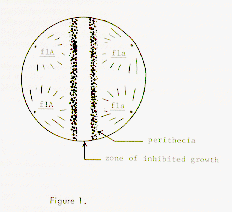
For the past two years the procedure described below, has been used at this University as an investigative exercise in a first year biology course. The success of this lab in a course of well over 1500 students illustrates that Neurospora can in fact be used on a large scale in teaching with none of the horrors usually anticipated with this species. The secret is to use aconidial fluffy strains, which virtually eliminates the risk of cross-contamination. *
For the student, the purpose of the exercise is to determine the life
cycle of an unnamed mold. Each group of four students is given a plate
of crossing medium, two cultures labelled A (fl A, FGSC #3249)
and B (fl a, FGSC #3250), and a small bundle of sterile toothpicks
wrapped in aluminum foil. The students are instructed to examine strains
A and B for any visible differences. Using the toothpicks, the strains
are then inoculated onto the medium as shown in figure 1. The plates, kept
in drawers, are observed weekly for three weeks and a record is kept of
events occurring at the macroscope level, and, as far as available equipment
allows, at the microscopic level. Obviously, details such as ploidy levels
and meiotic sequences cannot be determined, but intelligent guesses based
on careful observations can be made, and a reasonable facsimile of the
Neurospora life cycle can be derived.

One intriguing complication arises since the plates show a double line
of perithecia bordering a zone of what is presumably vegetative incompatibility
(figure 1). This striking 'racing stripe' down the middle of the plate
gives the students another puzzle to think about.
This exercise has produced a favorable student response and stimulated
much useful discussion. It is a simple, reliable, and challenging experiment
and the students' goals are clearly defined and generally well understood.
The exercise can be used as a vehicle for a variety of teaching purposes,
not the least of which is to introduce haploids and microbes at an early
point in the curriculum.
*The cross-contamination problem could be solved in other ways. For example, the use of conidial separation - defective (csp) mutants considerably reduces the risk of dispersal of aerial particles. However, only fluffy has been tested on a largescale.
- - - Department of Botany, University of British Columbia, Vancouver, B.C., Canada V6T 1W5.